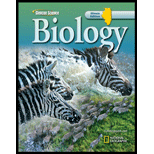
Concept explainers
To discuss:
The advantages and disadvantages of selective breeding.
Introduction:
The process by which desired traits of certain plants and animals are selected and passed on to their future generations is called selective breeding. This can be achieved through hybridization and inbreeding. It increased the frequency of desired allele within a population.
Answer to Problem 7A
Advantages of selective breeding:
Increases food production
Hybrids have better adaptability to changes in the environment
Produce large number of offspring
Hybrids have desired traits
Inbreeding helps in maintaining pure breeds
Disadvantages of selective breeding:
Hybridization is time consuming
Expensive Inbreeding causes loss of variation
Harmful recessive traits can be passed on to future generations
Explanation of Solution
Advantages of selective breeding:
Increases food production- Hybrid plants can be bred to be more nutritious, disease resistant and bear large fruits. Many crop plants like maize, wheat, rice and garden flowers are produced by hybridization. High yielding varieties have been developed to decrease food shortage.
Hybrids have better adaptability to changes in the environment- The selected traits give hybrids a competitive edge and a better ability to adapt to the changes in the environment as they are stronger and disease resistant. The offspring produced by crossing two pure breed plants are often stronger and larger than their parent plants.
Produce large number of offspring- Hybridization results in production of large number of offspring.
Hybrids have desired traits- Organisms with desired traits can be produced by crossing parent organisms with different forms of a trait.
Inbreeding helps in maintaining pure breeds- Pure breeds can be maintained by inbreeding as it results in offspring that are homozygous for most traits. Augus cattle and German shepherd dogs are examples of organisms produced by inbreeding.
Disadvantages of selective breeding:
Hybridization is time consuming- It took rice breeders three decades to produce high yielding hybrid rice variety. Selective breeding requires time, patience and several generations of offspring before the desired trait becomes common in a population.
Expensive- Since several hybrids are to be produced and tested, the entire process is very expensive.
Inbreeding causes loss of variation- During inbreeding the undesired traits are eliminated. It leads to loss of variation in characters over the generations.
Harmful recessive traits can be passed on to future generations- Inbreeding increases the chances of homozygous recessive offspring. So if both parents carry the recessive allele, the harmful trait will not get eliminated and will be expressed in future generations.
Chapter 13 Solutions
Biology Illinois Edition (Glencoe Science)
Additional Science Textbook Solutions
Campbell Biology (11th Edition)
Human Physiology: An Integrated Approach (8th Edition)
Campbell Biology in Focus (2nd Edition)
College Physics: A Strategic Approach (3rd Edition)
Organic Chemistry (8th Edition)
Introductory Chemistry (6th Edition)
- students in a science class investiged the conditions under which corn seeds would germinate most successfully. BAsed on the results which of these factors appears most important for successful corn seed germination.arrow_forwardI want to write the given physician orders in the kardex formarrow_forwardAmino Acid Coclow TABle 3' Gly Phe Leu (G) (F) (L) 3- Val (V) Arg (R) Ser (S) Ala (A) Lys (K) CAG G Glu Asp (E) (D) Ser (S) CCCAGUCAGUCAGUCAG 0204 C U A G C Asn (N) G 4 A AGU C GU (5) AC C UGA A G5 C CUGACUGACUGACUGAC Thr (T) Met (M) lle £€ (1) U 4 G Tyr Σε (Y) U Cys (C) C A G Trp (W) 3' U C A Leu בוט His Pro (P) ££ (H) Gin (Q) Arg 흐름 (R) (L) Start Stop 8. Transcription and Translation Practice: (Video 10-1 and 10-2) A. Below is the sense strand of a DNA gene. Using the sense strand, create the antisense DNA strand and label the 5' and 3' ends. B. Use the antisense strand that you create in part A as a template to create the mRNA transcript of the gene and label the 5' and 3' ends. C. Translate the mRNA you produced in part B into the polypeptide sequence making sure to follow all the rules of translation. 5'-AGCATGACTAATAGTTGTTGAGCTGTC-3' (sense strand) 4arrow_forward
- What is the structure and function of Eukaryotic cells, including their organelles? How are Eukaryotic cells different than Prokaryotic cells, in terms of evolution which form of the cell might have came first? How do Eukaryotic cells become malignant (cancerous)?arrow_forwardWhat are the roles of DNA and proteins inside of the cell? What are the building blocks or molecular components of the DNA and proteins? How are proteins produced within the cell? What connection is there between DNA, proteins, and the cell cycle? What is the relationship between DNA, proteins, and Cancer?arrow_forwardWhy cells go through various types of cell division and how eukaryotic cells control cell growth through the cell cycle control system?arrow_forward
 Human Anatomy & Physiology (11th Edition)BiologyISBN:9780134580999Author:Elaine N. Marieb, Katja N. HoehnPublisher:PEARSON
Human Anatomy & Physiology (11th Edition)BiologyISBN:9780134580999Author:Elaine N. Marieb, Katja N. HoehnPublisher:PEARSON Biology 2eBiologyISBN:9781947172517Author:Matthew Douglas, Jung Choi, Mary Ann ClarkPublisher:OpenStax
Biology 2eBiologyISBN:9781947172517Author:Matthew Douglas, Jung Choi, Mary Ann ClarkPublisher:OpenStax Anatomy & PhysiologyBiologyISBN:9781259398629Author:McKinley, Michael P., O'loughlin, Valerie Dean, Bidle, Theresa StouterPublisher:Mcgraw Hill Education,
Anatomy & PhysiologyBiologyISBN:9781259398629Author:McKinley, Michael P., O'loughlin, Valerie Dean, Bidle, Theresa StouterPublisher:Mcgraw Hill Education, Molecular Biology of the Cell (Sixth Edition)BiologyISBN:9780815344322Author:Bruce Alberts, Alexander D. Johnson, Julian Lewis, David Morgan, Martin Raff, Keith Roberts, Peter WalterPublisher:W. W. Norton & Company
Molecular Biology of the Cell (Sixth Edition)BiologyISBN:9780815344322Author:Bruce Alberts, Alexander D. Johnson, Julian Lewis, David Morgan, Martin Raff, Keith Roberts, Peter WalterPublisher:W. W. Norton & Company Laboratory Manual For Human Anatomy & PhysiologyBiologyISBN:9781260159363Author:Martin, Terry R., Prentice-craver, CynthiaPublisher:McGraw-Hill Publishing Co.
Laboratory Manual For Human Anatomy & PhysiologyBiologyISBN:9781260159363Author:Martin, Terry R., Prentice-craver, CynthiaPublisher:McGraw-Hill Publishing Co. Inquiry Into Life (16th Edition)BiologyISBN:9781260231700Author:Sylvia S. Mader, Michael WindelspechtPublisher:McGraw Hill Education
Inquiry Into Life (16th Edition)BiologyISBN:9781260231700Author:Sylvia S. Mader, Michael WindelspechtPublisher:McGraw Hill Education





